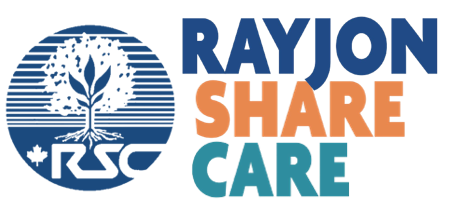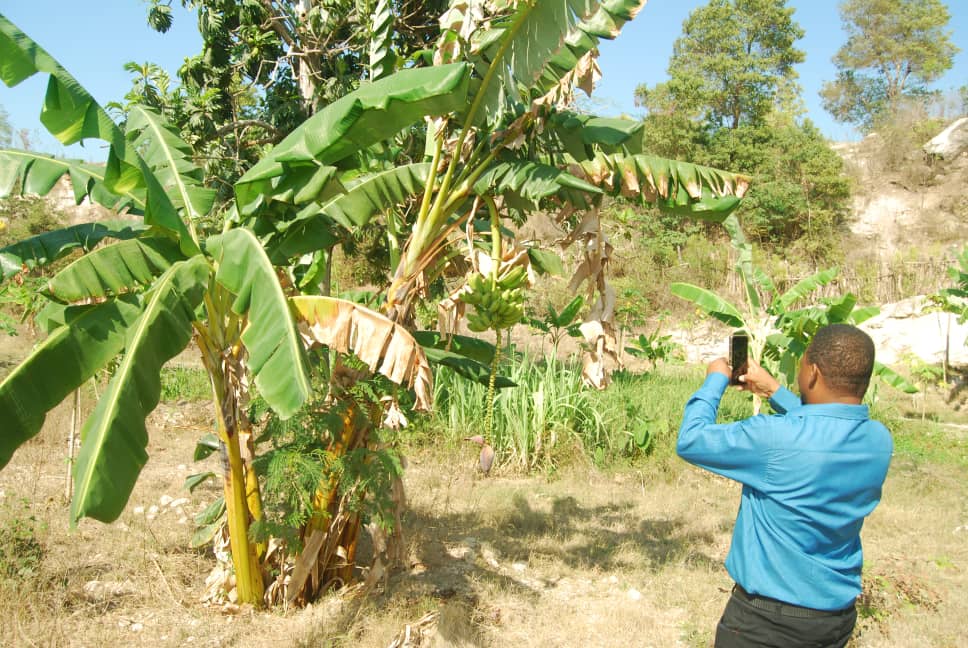At Rayjon, our programs are led by the communities themselves—because we believe the people who live there are the true experts. They tell us what their priorities are, and we listen. Across several communities we partner with, two common goals have emerged: the need for consistent access to healthy food and the urgent call to restore the environment. In response, we’ve found meaningful ways to integrate sustainable agriculture and food production into a variety of initiatives. What follows are powerful stories of growth—both in the gardens themselves and in the lasting, transformative impact they’re having.
Abundance of food and clean water transform lives into the village of Grand-Fond, Haut Saint-Marc, Haiti
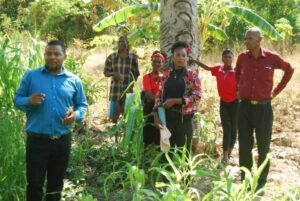
RSCH staff and Women’s Federation members visit the Grand-Fond garden
Grand-Fond, a dry village in Haiti’s Haut Saint-Marc region, has long struggled with environmental degradation and water shortages. Charcoal production, the main source of income, has caused widespread deforestation and left the land overused and fragile, despite a few families raising free-range goats. Water access was especially critical, with a single pond used for drinking, bathing, laundry, and livestock, requiring long daily trips.
The land was tired. The people were determined. But something had to change.
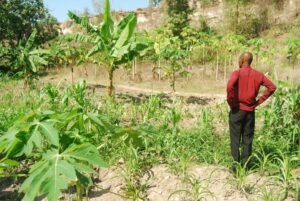
M. Luckner (RSCH’s Alpha Adult literacy director) overlooks some of the growth
With the support of the Primate’s World Relief and Development Fund (PWRDF), Rayjon Share Care, and the local Women’s Federation of Haut-Saint-Marc (FEFEH), the community came together to take action. A clean water system was built, finally offering safe, reliable water access close to home. But it was what came next that truly transformed Grand-Fond—an idea to reclaim the land through sustainable agriculture. A demonstration farm, designed not just to grow food, but to restore the environment, spark learning, and nourish a whole community.
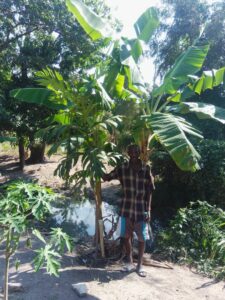
Garden Caretaker Elou Nazar stads with Plantain trees that have been growing strong
The farm began with hard work and humble tools. FEFEH members dug deep planting pits by hand, enriching the soil with manure and compost. In carefully planned groupings, they planted banana, papaya, and breadfruit trees, which offered mutual shade and protection. Groundcover crops like pumpkin and watermelon helped retain moisture in the dry soil. After the first good rain, the planting expanded—corn, beans, spinach, taro, sugarcane, and even rice lined the runoff paths, making the most of every drop of water.
Today, the community calls it the “Farm of Deliverance”—a space where hope grows alongside fruit. The farm produces food year-round. Harvests are eaten locally, donated to families in need, or sold to generate income. It’s become a symbol of what’s possible when communities lead their own transformation—with knowledge, tools, and a little help.
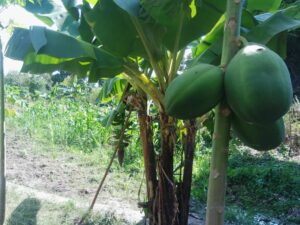
Papayas growing and ready to be harvested!
The impact goes far beyond the rows of crops. Hundreds of pumpkins, watermelons, and papayas have been harvested and distributed throughout the village—offering not just nourishment but also seeds for families to begin planting at home. The feedback has been overwhelming. People feel proud. People feel hopeful.
Word has spread quickly. Students from nearby schools and churches now visit the farm regularly to learn about water conservation, sustainable planting, and land stewardship. Some even call it a “park of attraction,” drawn in by its creativity and beauty.
Inspired by the farm, over eighty local farmers have been trained to design and build their own backyard gardens. Each garden is unique—adapted to family needs and land size—but all follow the farm’s model. Households reuse greywater to nourish “banana circles,” where banana and papaya trees grow in synergy, just like on the main site. Families who fenced off their plots to protect from wandering goats were gifted breadfruit saplings from the FEFEH nursery.
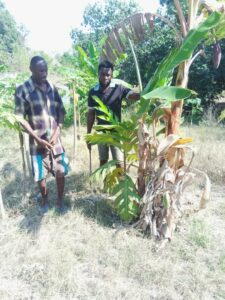
Community members ready to harvest!
These methods are not only working—they’re flourishing. Families now grow food year-round while conserving water and improving soil health.
As trees mature, the landscape is becoming greener. Birds are returning, and the area is growing more beautiful and alive. The demonstration farm, once just a vision, now stands as proof that sustainable agriculture and clean water access can work together to transform a community. Other villages are taking note, and the project is inspiring ideas for replication beyond Grand-Fond.
Nutritious Gardens and Shady Trees Nurture Young Lives at PLADESCULBA in Consuelo, Dominican Republic
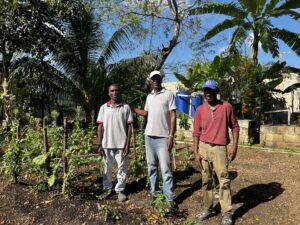
Kesnol, Georges and Elia (from left to right) standing in the garden in 2025
Georges had a challenge. As the leader of PLADESCULBA in Barrio 41, Consuelo, he wanted to offer healthier meals to preschoolers—many of whom relied on school for their most nutritious food of the day. But fresh produce was hard to come by, and the land around the school didn’t offer much help.
Barrio 41 was built by families once displaced from nearby sugarcane plantations. The land had once been a garbage dump, later covered with a thin layer of soil. Though the preschool had been slowly built, brick by brick, the surrounding yard remained dry, dusty, and bare—offering no shade, no greenery, and no food.
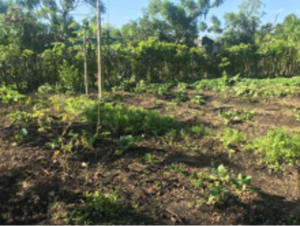
The very beginning of the garden!
Georges saw potential where others saw problems. His vision? A community garden. One that would not only feed the children, but transform the space into something living, welcoming, and full of purpose. A place to grow vegetables, plant trees, and bring the community together—one harvest at a time.
Since those early days, the garden has flourished. Towering plantain and mango trees now sway in the breeze, offering shade and fruit, while rows of consistently producing vegetables fill the garden beds. Every day, produce from the garden incorporated into the nutritious meals served to the preschoolers. For students who may not have regular access to balanced meals at home, these lunches are more than just food—they’re building blocks for healthy development.
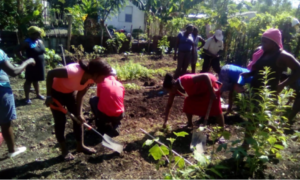
Women from Barrio 41 participating in the horticulture program
The garden has also become a hub for education and community empowerment. The PLADESCULBA staff has led horticultural training courses have been offered right on-site, using the garden as a living classroom. Many of the participants being women from the community, empowering them through a new skill. Community members have learned planting techniques and sustainable agriculture—all rooted in the unique conditions of Barrio 41.
At the heart of it all are Kesnol and Elia, the devoted caretakers of the garden. Their hands tend every plant, and their knowledge and passion have helped the garden thrive. Their leadership has turned this once barren space into a vibrant example of what’s possible when a community comes together.
With support from partners PUENTE Desarrollo International, a rain catchment and irrigation system was installed to make the garden more resilient in the face of climate variability. This system now waters the rows of crops efficiently and sustainably, even in times of drought—ensuring that the children’s meals continue without interruption.
Not every experiment has gone according to plan. A fish-rearing project was launched using water from the catchment system, aimed at providing an additional protein source for student meals. Unfortunately, despite best efforts, the fish didn’t survive. Some were stolen, others died before reaching maturity. The garden’s open and welcoming nature—its greatest strength—also presented challenges in protecting more delicate projects.

Mature trees providing shade in the PLADESCULBA courtyard
Years ago, non-fruit-bearing trees were planted around the preschool courtyard, with the hope that one day they’d offer shade to the children playing there. That vision has come true. The once-exposed yard is now protected by a leafy canopy, offering a cool, inviting space for students to laugh, learn, and grow—even on the hottest days.
From dream to community reality, the garden at PLADESCULBA is much more than a source of food. It’s a symbol of resilience, innovation, and care—a thriving green heart in a place once written off as barren. And like all good gardens, its roots are still growing deeper.
